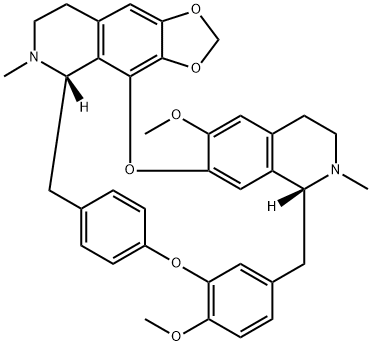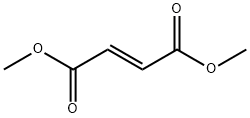Cepharanthine
- CAS NO.:481-49-2
- Empirical Formula: C37H38N2O6
- Molecular Weight: 606.71
- MDL number: MFCD00210482
- EINECS: 228-085-1
- SAFETY DATA SHEET (SDS)
- Update Date: 2024-11-26 11:58:42

What is Cepharanthine?
Description
Cepharanthine is diclofenac quinoline alkaloid isolated from rhizome of Stephania japonica, which was first recorded in “Bencao shiyi” and functions as clearing heat, promoting diuresis and detumescence in traditional Chinese medicine. Cepharanthine is a pure and natural extract of the Stephania cepharantha Hayata plant, a rare species that is native to Kotosho Island, southeast of Taiwan. In 1914, the renowned botanist, Bunzo Hayata reported the plant for the first time. Two decades later, Dr. Heisaburo Kondo purified its active ingredient and named it “Cepharanthine.” Stephania japonica was used to treat tuberculosis and other consumptive diseases which provided a clue for its development on lung disease.
Physical properties
Appearance: light yellow or yellow powder. Solubility: soluble in acidic aqueous solution and ether, acetone, and other organic solvents; insoluble in petroleum ether. Melting point: 148–150?°C. Specific optical rotation: +277°.
History
Promoting leukocytosis of cepharanthine in tuberculosis patients was first recorded in the proceeding Institute of Chemotherapy by the Japanese scholar Yamaguchi in 1946. In 1948, Chinese scholar Yuhuang Zhao also received this compound and published it in D.M.?Med.
It is thought that cepharanthine may stimulate the reticuloendothelial system, then activate hematopoietic tissue, and promote myeloproliferation. Therefore, the number of white blood cells in the peripheral blood increased significantly. Due to its good safety, cepharanthine is currently widely used in cancer patients with granulocytopenia or leukopenia embolism after radiotherapy and chemotherapy and so on.
In addition, Chinese scientists extracted five kinds of dibenzylisoquinoline alkaloids from Chinese herbal medicine in 1977, which could significantly improve the
silicosis symptoms in rat . In 1993, it was issued as anti-pneumoconiosis drug by
CFDA and is used for delaying the progress of pneumoconiosis in clinic.
The Uses of Cepharanthine
Cepharanthine is a biscoclaurine alkaloid that has antiinflammatory, antineoplastic, hepatoprotectant, radiopropective and other biological functions. It is used to treat many acute and chronic diseases, including pit viper bites, alopecia areata, and leucopenia in radiation therapy.
What are the applications of Application
Cepharanthine is a biscoclaurine alkaloid that has antiinflammatory and other biological functions
Definition
ChEBI: Cepharanthine is a bisbenzylisoquinoline alkaloid from tubers of Stephania; stimulates recovery of immunologic function in lymphatic system after administration of antineoplastic agents or x-irradiation. It is a member of isoquinolines and a bisbenzylisoquinoline alkaloid.
Benefits
When Cepharanthine is absorbed into the body, it acts through multiple biochemical and pharmacological mechanisms and generates a tremendous amount of beneficial effects on one's health.
Regrow hair in a number of patients with different types of alopecia
Inhibit various types of cancerous tumor growth
Prevent cancer metastasis
Stimulate white blood cell production
Induce apoptosis (cell death) and autophagy in cancerous cells
Restore the effectiveness of anticancer drugs for resistant tumors
Boost the effectiveness of certain chemotherapies
Inhibit the replication of HIV-1 virus
Inhibit different types of Coronavirus
Provide relief of allergies by inhibiting the release of histamine
Possess anti-viral and anti-inflammatory effects
Scavenge free radicals and prevent oxidation
Biological Activity
Cepharanthine, a biscoclaurine alkaloid isolated from a Chinese folklore plant Stephania cepharantha, inhibited HIV-1 replication by inhibiting kappa B, a potent inducer of HIV-1 gene expression and displayed potent activity against SARS coronavirus, HSV-1, and coxsackie B3 along with antitumor and immunomodulating activity. As cepharanthine had strong activity against both RNA and DNA viruses it may be a source of potential lead compounds for developing new antivirals.
Pharmacology
The pharmacological effects of cepharanthine are very broad, mainly for the promotion of leukocytosis, antitumor, anti-inflammation, improvement of the body immunity, and other aspects of efficacy. Improvement of leukocytosis is the most widely
studied among them, and the mechanism may be to stimulate the reticular endothelium system, activate hematopoietic tissue, and promote bone marrow hyperplasia .
Cepharanthine is also a good antitumor drug sensitizer. It can significantly
improve their efficacy and reduce their side effects when combined with other antitumor drugs, as manifested by increasing the concentration of FT-207 metabolite
(5-Fu) in tumor tissue under cepharanthine and FT-207 combination therapy, which
was significantly higher than that in blood , suggesting that cepharanthine has the
potential to improve the efficacy of antitumor drugs.
Clinical Use
The major clinical application of cepharanthine is to improve their immunity impaired by chemotherapy or radiotherapy in tumor patients. In addition, cepharanthine can increase the sensitivity to antitumor drugs, and itself also has a certain antitumor effect. Now, it is commonly used as adjuvant drug for anticancer treatment.
Side Effects
Cepharanthine is an extraordinary medicine from Japan, where it has been widely used for the past seventy years to treat a variety of acute and chronic diseases, with little known side-effects.
Common side effects are reported as below.
loss of appetite, disc omfort in stomach, rash/eruption, itch , nausea, diarrhea, headache, dizziness, swelling in face/hands/feet, irregular menstruation, etc.
References
Rogosnitzky and Dank (2011), Therapeutic potential of the biscoclaurine alkaloid, cepharanthine, for a range of clinical conditions; Pharmacol. Rep., 63 337 Huang et al. (2014), Cepharanthine, an alkaloid from Stephania cepharantha Hayata inhibits the inflammatory response in the RAW264.7 cell and mouse models; Inflammation, 37 235 Wang et al. (2020), Cepharanthine hydrochloride induces mitophagy targeting GPR30 in hepatocellular carcinoma (HCC); Expert Opin. Ther. Targets, 24 389 Zhang et al. (2019), Downregulation of MYO1C mediated by cepharanthine inhibits autophagosome-lysosome fusion through blockade of the F-actin network; J. Exp. Clin. Cancer Res. 38 457 Rosognitzky et al. (2020), Cepharanthine: a review of the antiviral potential of a Japanese-approved alopecia drug in COVID-19; Pharmacol. Rep., 72 1509
Properties of Cepharanthine
| Melting point: | 145-155° |
| Boiling point: | 654.03°C (rough estimate) |
| alpha | D20 +277° (c = 2 in chloroform) |
| Density | 1.1761 (rough estimate) |
| refractive index | 1.5300 (estimate) |
| storage temp. | under inert gas (nitrogen or Argon) at 2-8°C |
| solubility | Soluble in DMSO (35 mg/mL) or ethanol (20 mg/mL) |
| form | solid |
| pka | 7.61±0.20(Predicted) |
| color | Pale yellow |
| Stability: | Stable for 2 years from date of purchase as supplied. Solutions in DMSO may be stored at -20°C for up to 2 months. |
Safety information for Cepharanthine
Computed Descriptors for Cepharanthine
| InChIKey | YVPXVXANRNDGTA-WDYNHAJCSA-N |
| SMILES | C1CC2C=C3OCOC3=C3OC4C(OC)=CC5CCN(C)[C@]([H])(CC6=CC(=C(OC)C=C6)OC6C=CC(C[C@@]([H])(C=23)N1C)=CC=6)C=5C=4 |
New Products
(S)-3-Aminobutanenitrile hydrochloride 4-Methylphenylacetic acid N-Boc-D-alaninol N-BOC-D/L-ALANINOL Tert-butyl bis(2-chloroethyl)carbamate 3-Morpholino-1-(4-nitrophenyl)-5,6-dihydropyridin- 2(1H)-one Furan-2,5-Dicarboxylic Acid Tropic acid 1-Bromo-3,5-Di-Tert-Butylbenzene S-2-CHLORO PROPIONIC ACID ETHYL ISOCYANOACETATE 2-Bromo-1,3-Bis(Dimethylamino)Trimethinium Hexafluorophosphate 4-IODO BENZOIC ACID 3-NITRO-2-METHYL ANILINE 1-(2,4-DICHLOROPHENYL) ETHANAMINE (2-Hydroxyphenyl)acetonitrile 4-Bromopyrazole 2-(Cyanocyclohexyl)acetic acid 4-methoxy-3,5-dinitropyridine 1-(4-(aminomethyl)benzyl)urea hydrochloride 2-aminopropyl benzoate hydrochloride diethyl 2-(2-((tertbutoxycarbonyl)amino) ethyl)malonate tert-butyl 4- (ureidomethyl)benzylcarbamate Ethyl-2-chloro((4-methoxyphenyl)hydrazono)acetateRelated products of tetrahydrofuran








You may like
-
 Cepharanthine 98% (HPLC) CAS 481-49-2View Details
Cepharanthine 98% (HPLC) CAS 481-49-2View Details
481-49-2 -
 2033-24-1 98%View Details
2033-24-1 98%View Details
2033-24-1 -
 1975-50-4 98%View Details
1975-50-4 98%View Details
1975-50-4 -
 2-HYDROXY BENZYL ALCOHOL 98%View Details
2-HYDROXY BENZYL ALCOHOL 98%View Details
90-01-7 -
 2-Chloro-1,3-Bis(Dimethylamino)Trimethinium Hexafluorophosphate 221615-75-4 98%View Details
2-Chloro-1,3-Bis(Dimethylamino)Trimethinium Hexafluorophosphate 221615-75-4 98%View Details
221615-75-4 -
 61397-56-6 CIS BROMO BENZOATE 98%View Details
61397-56-6 CIS BROMO BENZOATE 98%View Details
61397-56-6 -
 14714-50-2 (2-Hydroxyphenyl)acetonitrile 98+View Details
14714-50-2 (2-Hydroxyphenyl)acetonitrile 98+View Details
14714-50-2 -
 118753-70-1 98+View Details
118753-70-1 98+View Details
118753-70-1